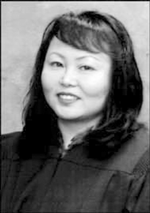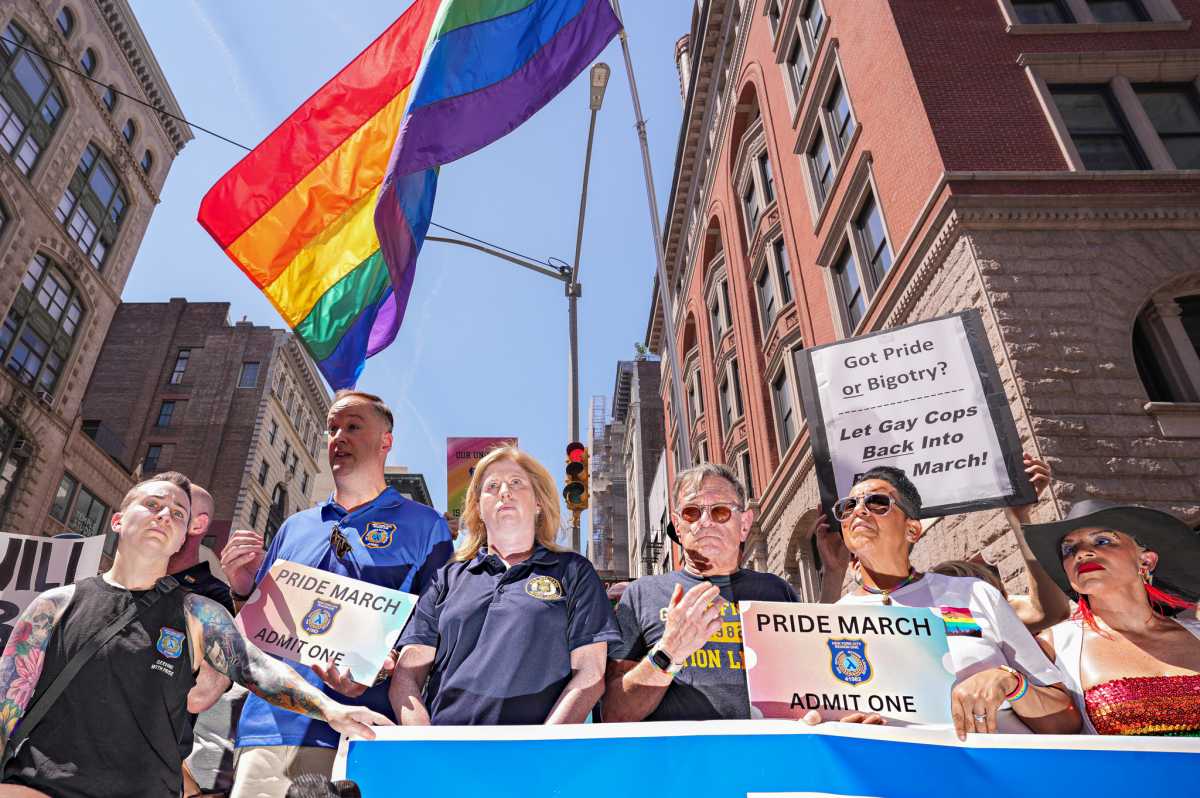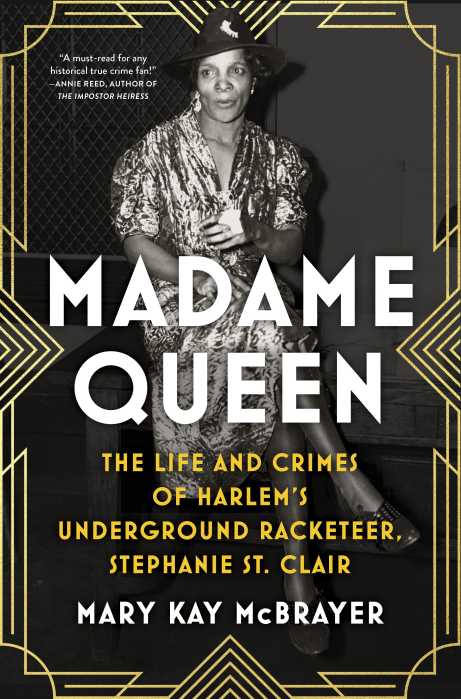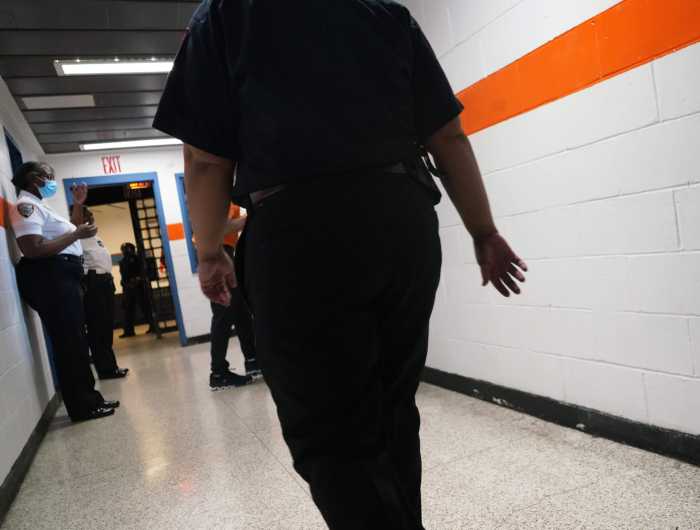Judge finds state constitutional right to same-sex marriage but stays decision
In a lengthy opinion released on February 4, New York State Supreme Court Justice Doris Ling-Cohan ruled in favor of five same-sex couples represented by Lambda Legal who had sued Victor Robles, the city clerk, to compel him to issue them marriage licenses.
Ling-Cohan stayed her order for 30 days to give the city an opportunity to appeal. After State Attorney Gen. Spitzer, a Democrat, declined to appeal the case, Republican Mayor Michael Bloomberg said that he would do so, having been advised by the city’s Law Department that it disagreed with the court’s conclusions. The mayor did, however, state that he personally supports the right of same-sex couples to marry, and hoped that the state’s highest court would agree with the trial judge.
As appeals are pending in two other marriage cases decided outside New York City, Spitzer joined with City Corporation Counsel Michael Cardozo in agreeing to ask the appellate courts to consolidate all three cases for an expedited review in the Court of Appeals. Although this would be unusual, Cardozo’s office indicated that when the only question in a case is the constitutionality of a statute, the Court of Appeals has in the past allowed parties to skip the intermediate appellate court and bring the matter directly to the state’s highest court.
Ling-Cohan found that Robles’ refusal to issue the licenses last year, on advice of the Law Department, violated two provisions of the state Constitution, the due process clause and the equal protection clause.
“It was only less than 40 years ago that the United States Supreme Court held that anti-miscegenation statutes, adopted to prevent marriages between persons solely on the basis of racial classification, violate the Constitution because they infringed on the freedom to marry a person of one’s choice,” Ling-Cohan wrote. “Similarly, this Court must so hold in the context of same-sex marriages.”
The court did not plow any new ground in this case, since two upstate town judges from New Paltz have also ruled that same-sex partners have a right to marry in New York, but those rulings came in the context of criminal prosecutions of persons who had performed marriage ceremonies and were incidental to rulings to dismiss those charges.
Just one day before Ling-Cohan’s ruling, however, an upstate judge, Michael Kavanaugh, issued an opinion rejecting a challenge to the state marriage law.
During the past year and a half, the Massachusetts Supreme Judicial Court and two trial courts in the state of Washington have ruled that state constitutional principles of equality and liberty required opening up the institution of marriage to same-sex couples, and Ling-Cohan borrowed heavily from those rulings. Even more importantly, the U.S. Supreme Court’s 2003 ruling in Lawrence v. Texas, striking down the Texas sodomy law, embraced a broad view of protected liberty that provided a major support for the recent decisions on marriage in those other jurisdictions.
The lawsuit was unusual in that the plaintiffs sued the city clerk because his office refused to issue licenses, but the real defendant, of course, is the state, whose statute is the basis for denying the licenses. Although the attorney general’s office was invited to intervene in the case to defend the marriage statute, Spitzer declined to do so, leaving the defense of the case to the city’s Law Department. Spitzer has been put into a contradictory situation, since he authorized an opinion letter last spring stating that the current marriage law does not allow for same-sex marriage, but that its failure to do so raises serious constitutional questions.
On the other hand, Spitzer’s office is defending the marriage law in other lawsuits pending outside the city, in which his office has taken the position that the marriage law is constitutional. Plaintiffs have appealed rulings from trial judges in those cases upholding the marriage law, so the appeals courts will now confront conflicting rulings as they try to sort this matter out.
The case before Ling-Cohan was simplified somewhat by the city’s decision to accept key factual contentions that Lambda advanced in support of the plaintiffs’ claims. There was no dispute that same-sex couples form families, that several of the plaintiff couples are raising children and that exclusion from marriage imposes significant disadvantages on the couples and their children, because of the many rights and responsibilities associated with marriage that cannot be completely replicated through other legal mechanisms.
Lambda, in its lawsuit did not challenge the conclusion that both Spitzer and the city’s Law Department came to last year—that the existing state law does not provide for same-sex marriage. Ling-Cohan, early in her opinion, voiced her agreement with that view.
Despite their acknowledgment of hurdles faced by unmarried gay couples and their children, city attorneys argued that there were two justifications for rejecting the plaintiffs’ constitutional claims—first, that the city has a legitimate interest in maintaining the traditional form of marriage as a union of one man and one woman, and second, that the city has a legitimate interest in avoiding conflict with the laws of other jurisdictions, including the federal government, which prevent them from recognizing same-sex marriages performed in New York.
Ling-Cohan found those state interests insufficient in light of the liberty and equality interests at stake, and contradictory to recent trends in New York law, which have uniformly given more recognition and rights to same-sex families.
The opinion opens by drawing a strong analogy between the same-sex marriage dispute and the controversy two generations ago about interracial marriages, and uses as a striking example the fact that the parents of Curtis Woolbright, one of the plaintiffs in the case, had to move from Texas to California to get married, because Texas prohibited such marriages while California’s Supreme Court was the first in the nation to strike down a legislative ban on interracial marriages.
In a 1967 decision in Loving v. Virginia, the Supreme Court ruled that using a racial classification to restrict the right to marry violates a fundamental liberty that every person has to choose their marital partner, and that excluding mixed-race couples from marriage violated the basic commitment to equal protection under the law embodied in the 14th Amendment. The New York State Constitution also expresses a commitment to protecting individual liberty and equality, and, as Ling-Cohan found, state courts have found even greater protection under the state Constitution for individual rights than the federal courts have provided.
But she analyzed the legal issues in terms of both federal and state judicial precedents, placing significant weight on the U.S. Supreme Court’s 2003 Lawrence sodomy opinion. Although Justice Anthony Kennedy, who wrote the majority opinion, stated that Lawrence made no finding on whether the state had to confer any particular legal status on same-sex relationships, nonetheless the opinion clearly suggested that the right to enter into such relationships enjoyed the same kind of constitutional protection as the right of choice in marital partners. Justice Antonin Scalia, in his dissent, warned in obvious distress that the Lawrence decision was opening the way to a right of same-sex couples to marry and Ling-Cohan took note of that.
In her finding that the fundamental right to marry includes the right to marry the person of one’s choice, Ling-Cohan relied on the Loving decision and on the 2003 Massachusetts marriage case, Good ridge, where the court stated, “The right to marry means little if it does not include the right to marry the person of one’s choice.” In 1982, the New York Court of Appeals had also addressed the marital choice issue, in the context of discussing the state constitutional right to privacy, and said “clearly falling within its scope are matters relating to the decision of whom one will marry.” “It is clear,” wrote Ling-Cohan, “that moral disapproval of same-sex couples or of individual homosexuals is not a legitimate state purpose or a rational reason for depriving plaintiffs of their right to choose their spouse. In weighing the significance of the traditional institution of marriage, one must take into account the Supreme Court’s rejection of the elements of distaste or moral disapproval.”
Ling-Cohan also rejected the defendants’ attempt to link marriage and procreation as reason for denying same-sex couples the right to marry. Several of the plaintiff couples are raising children, some conceived through donor insemination, and census data show that a substantial minority of same-sex couples in New York, both female and male, are raising children.
“Excluding same-sex couples from marrying may, in fact, undermine the State’s interest in providing optimal environments for child-rearing, in that children of those families are then not afforded the same legal, financial and health benefits that children of married couples receive,” the judge wrote. Ling-Cohan found that New York State law has evolved to extend significant recognition to same-sex partners, particularly regarding their relationship to children, especially noting court decision on gay adoption and second-parent adoption, as well as the historic Braschi decision from 1987 in which the Court of Appeals ruled that two gay men living together could be considered a family for purposes of the rent control law.
The court was also dismissive of the city’s argument that the state could deny same-sex couples the right to marry “on the basis of discrimination countenanced by other States and the Federal government,” which was how the judge re-characterized the city’s argument. Ling-Cohan asserted that “this simply cannot be a legitimate ground for denying a liberty interest as important as marriage,” pointing out that when the California Supreme Court struck down that state’s law against interracial marriage in 1948, such marriages were not recognized in many other states. Quoting a phrase used by Supreme Court Justice John Paul Stevens in an opinion he wrote in an abortion case, Ling-Cohan said that it would be “‘irrational and perverse’ to deny such New York resident couples and their children the protections of marriage that they would enjoy under the laws of New York, on the ground that they will not have those protections under the laws of other States, or under those of the United States.”
Rejecting the city’s argument based on history, the judge wrote that “history demonstrates that marriage is not a stagnant institution,” and described the significant changes in the status of marriage that have taken place in New York law over the past two centuries, including radical changes in the status of women in marriage as well as the elimination of any racial limitations and the mid-20th century liberalization of divorce law.
“Permitting plaintiffs to marry would confer innumerable tangible and intangible benefits for them and their children while causing harm to no one,” wrote the judge. “Defendant has articulated no legitimate State purpose that is rationally served by a bar to same-sex marriage, let alone a compelling State interest in such a bar.”
The court also accepted the alternative argument of an equal protection violation, on grounds of sexual orientation discrimination, noting that in 1985 an appellate court in Manhattan specifically ruled that sexual orientation “cannot be used as the basis for denying ‘any person’ the equal protection of the law.”
In a lengthy concluding section, Ling-Cohan stated more affirmative reasons for her decision.
“As a society,” she wrote, “we recognize that the decision of whether and whom to marry is life-transforming. It is a unique expression of a private bond and profound love between a couple, and a life dream shared by many in our culture. It is also society’s most significant public proclamation of commitment to another person for life.”
Ling-Cohan also commented on the frequent argument that marriage has a religious basis and that religious objections to same-sex marriage should be considered in deciding a challenge to the marriage law.
“While, undeniably, religious institutions have a historical and spiritual interest in marriage and the recognition of those married under their tenets,” she wrote, “ultimately it is the government’s choice as to which relationships to recognize as valid civil marriages.”
gaycitynews.com

































